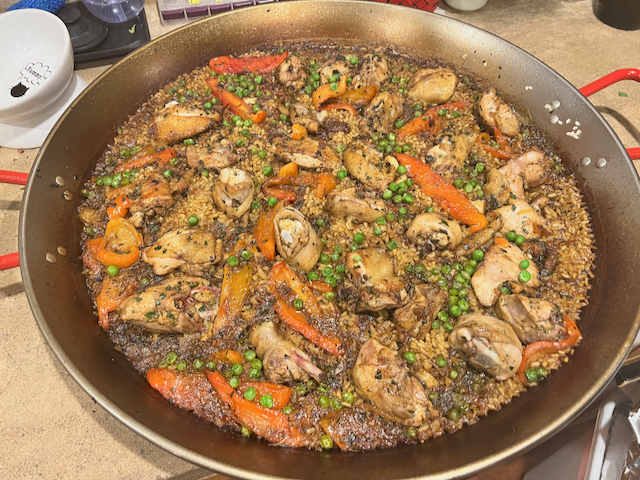 |
| Note the Blue Flame (its adjustable) |
Since the Pandemic started we have been interested in Spain: reading books (fiction and history) and watching streaming lectures about Spain on Zoom. We are committed to going there in May. Our friends Jaimie and Robert had us over for Paella in solidarity with our quest. Jaimie had purchased a Paella pan and cooking apparatus. After eating his Paella we decided to do the purchase our own and attempt to make it. We purchased ours at La Paella.
Paella, we have discovered, is all about the Rice and specifically the crust that forms at the lowest level of rice where it touches the pan (in Spanish called: Socarrat. (You don't stir Paella - you just let it cook). This was our first attempt. It was damn good. But I can't wait to try the real Paella in Valencia, Spain which is considered the home of the best Paella in Spain. We purchased the cookbook: Paella by Penélope Casas. She knows Paella well!
Rupert's Marinated Chicken Paella(Paella de Pollo Adobado "Ruperto")
Paella by Penelope Casas
Rupertos tapas bar is a legend in Sevilla, and his tapas keep bringing in the crowds. Although he does not serve paella at Casa Ruperto, he offered me his personal recipe, which uses the same marinade that makes his famous grilled quail and skewered pork so special. This is a succulent rice of exceptional flavor; the chicken, subtly seasoned with sherry, cumin, thyme, and nutmeg, and the marinade, which is incorporated into the paellas broth, bring a perfect balance to this dish.
Serves 8
3-1/2 pounds Chicken Thighs (with bone & skin) each cut in half (ask your butcher to do this)
Marinade (see below)
8 cups chicken broth, canned or homemade
¼ teaspoon crumbled thread saffron, toasted then crumbled
¼ cup olive oil
6 cloves garlic, peeled
1 medium tomato, halved then shredded on box greater, biggest shred
1 medium onion, halved then shredded on box greater, biggest shred
2 medium red bell peppers halved then cut into inch wide strips
1 bay leaf
¼ teaspoon saffron, toasted and ground in a powder
3 tablespoons minced parsley
3 cups imported Spanish or Arborio short-grain rice
½ cup frozen peas
1 lemon, cut in wedges
Marinade
8 teaspoons dry fino sherry or dry white wine
4 tablespoons extra-virgin olive oil
2 teaspoon ground cumin
Freshly ground black pepper to taste
6 teaspoons thyme leaves or 1 teaspoon dried
4 cloves, crushed
4 teaspoon ground nutmeg
1 bay leaf, crumbled
¼ teaspoon crushed red pepper
1 tablespoon minced parsley
½ teaspoon sweet paprika, preferably Spanish smoked
Kosher or sea salt to taste
In a bowl, combine the marinade ingredients. Fold in the chicken and turn to coat well. Marinate at least 1 hour at room temperature or longer in the refrigerator.
Remove the chicken pieces from the marinade (reserving the marinade but discarding the garlic) and dry on paper towels. Sprinkle all over with salt.
In a large pot, combine the chicken broth with the remaining marinade, (swirl a little of the chicken broth and the saffron in the bowl to remove it all) and the saffron. Keep hot over the lowest heat.
Pour ¼ cup olive oil in a paella pan. Over medium high heat, sauté the chicken until browned, 10 to 15 minutes. Transfer to a platter.
Reduce the heat to medium low. In the paella pan, cook the red pepper until the peppers are completely limp but not brown, 15 to 20 min. Transfer the peppers to a plate and cover with aluminum foil
Meanwhile, peel the skin off the red peppers.
Increase the heat to medium and sauté the onion until softened, about 5 min. Add the tomato, and the six garlic cloves, season with salt, and cook, stirring often, until the mixture has darkened to a deep burgundy and is thick like a compote, 15 to 20 min. If it starts to stick to the pan or burn, add a little water to the pan. If not cooking the rice immediately, remove the paella pan from the heat. (This tomato-onion-garlic mixture, called a sofrito, is the flavor base for the paella.) You may make the paella several hours ahead up to this point.
Spread the rice in the pan and pour in the hot broth. Shake the pan a bit to make sure the rice is evenly distributed. Arrange the chicken, red peppers, and peas in the pan.
Do not stir the rice from this point on. Simmer vigorously, moving the pan over one and two burners to distribute the heat and to cook the rice as evenly as possible. When the rice is at the same level as the liquid, after 8 to 10 min., reduce the heat to medium low.
Continue to simmer more gently, rotating the pan as necessary, until the liquid has been absorbed, about 10 min. more. Taste a grain just below the top layer of rice; it should be al dente, with a tiny white dot in the center. (If the rice is not done but all the liquid has been absorbed, add a bit more broth or water to the pan and cook a few minutes more.)
Increase the heat to medium-high and, rotating the pan, cook for about 2min., until the bottom layer of rice starts to caramelize, creating the socarrat. The rice will crackle, but if it starts to smell burned, remove the pan from the heat immediately.
Remove the pan from the heat. Cover loosely with foil or a clean kitchen towel and let the paella rest for 5 min. to even the cooking and let the flavors meld. Set the paella pan in the center of a round or square table. Remove the foil and invite people to eat directly from the pan, starting at the perimeter, working toward the center, and squeezing lemon over their section, if they want.
Serve with lemon wedges.





No comments:
Post a Comment